#the irish mobster episode
Explore tagged Tumblr posts
Text
c2x13 condensed post
Ok cuz I’m sure that’s how it works. Blood dripping from the ceiling? Not noticing it in your paint? not getting a gradual increase in the colour of your paint when the blood was slowly dripping in?
I own a boat! XD XD XD XD Johnny Vong this is hilarious & I love it but ryan is so dumb to fall for it like bro my dude girl come on (also apparently ryan's warm milk with honey really does help him sleep)
Ryan come on don’t fall for it
F yeah! As a Métis fiddler, uh 100/10 to celtic fiddlers. You deserve the world. I know that we have a lot of french/french canadian in us, but dang the scots & irish had the right idea & I’m so glad we took after them too.
As a Métis folk catholic, 10/10 to irish catholics. You deserve the world.
Yayyyyy Gil Mazzaro again!
Poor Lanie, she has to be the one to find out
Ryan seriously at work?
Wow that’s lowkey xenophobic but I’m glad he included texas
I’m honestly kind of sad it was sexy beckett. Ryan totally should have been the one to cut it open & give it a taste, he’s the ex-narcotics detective.
Ok walking on glass? Yes you want to be slow. Walking on coals? You want to run.
KR: & which boxes contain the secret path to financial independence. He says, while stroking the CD case GIRL WHAT YOU CAN’T BE THAT GULLIBLE THIS IS CULT STUFF BRO DON’T EVEN LOOK AT YOUR SHOES ARE YOU INSANE THIS MAN HAS YOU HYPNOTIZED LIKE MY DUDE YOU ARE ON A MURDER INVESTIGATION this is the best B plot ever. At least Esposito threatens to pepper spray him SHUT UP SHUT UP you’re just embarrassing yourself more, my dude, of course it is a scam, you literally already know it is a front for a drug smuggling company
I love Roy Montgomery.
I decided to text my dad because of this episode
I mean like yeah at least this gang is… preventing drug addiction? (& then in future episodes we have smth up with detective slaughter in like what s4? & then we have fenton oconnell in s5, & while finn rourke's gang prevents drug addiction bobby s's gang causes it)
Dick coonan. He’s surprisingly diplomatic
That’s a lot of dough
Esposito’s got a nice jacket tbh! also a nice gun & like they pushed down an old man so ew but still: fashionable
Captain just shoot the guy without revealing your position to like maim him or smth. Btw that’s a lot of blood, it takes time to get out. Like bro??? What is even going on?
At least she used the back of her hand to push her hair out of her face rather than her bloody hands.
Ok so it took me a bit less time to watch this episode, only an hour & 15 minutes. Last ep it took about 90 mins. Of course during both episodes I took a break, once to read smth another time to watch a video my dad sent me
#castle 2x13#castle 2x13 spoilers#rathborne/Dick Coonan#castle s2 spoilers#castle 2x13 quote#plot heavy#sucker punch#the dick coonan episode#the irish mobster episode
0 notes
Text
Boys Night Out Job review:
Mattingly hitting Hurley on his way into town
That one Shelly/Hardison fic...that fic had a point
"Terrorism and peanut allergies do not mix"
Underrated friendship: Shelly and Bonano
The Irish gangsters are my favorite characters in the whole show, actually. I want their church basement argument on a shirt
"Sister Lupe! Sister Lupe :("
These two episodes divided the energy of the show into two: the girls got the competence porn while the boys got the crazy shenanigans which is why it's my favorite of the two
"I'm a dirty cop, of course I'm a damned racist" -Hardison's response to the racism card being pulled on him for the first time
"Rapture!"
Should there be an actual priest in this church?
IMDB says the other Irish mobster is named Connor. I knew Liam's name but not Connor's.
I love the impound lot guard, she's so cute
Eliot's reverse psychology
The Mexicans spend the entire episode patting themselves on the back, thinking this is the best night ever for them. Right up until the Irish start shooting
CLASSIC gloat drive by. "I don't think he's a priest either"
Parker behind the bar in the final scene, which is normally's Nate's spot, after her giving Sophie and Tara orders last ep
15 notes
·
View notes
Text
Wow, I’ve discovered this today and I’m hyperventilating.
Miller’s Crossing, but not the Stargate episode. Turns out there is an actual movie. Turns out, it’s a homoerotic unrequited gay love story?? They call it Gay Irish Gangster Epic??
I haven’t watched it (yet), but there is this wonderful primer that summarizes the dynamic between characters:
Ethan and Joel Coen’s 1990 mobster film Miller’s Crossing is a story of unrequited love between Gabriel Byrne’s protagonist and the mob boss played by Albert Finney.
The question of why Tom goes through his hellish path is at the heart of Miller’s Crossing, and the only answer that makes sense is that he does it all for Leo. No, the quest Tom embarks on in Miller’s Crossing is all for Leo, and the fact that–in spite of it all–he refuses to rejoin Leo’s mob after everything is said and done is proof that he does it for something more than just friendship. He refuses to go back to his old job both because he can’t stand to see Leo with someone else, and because even if Verna were out of the picture, pursuing Leo wouldn’t be realistic because of the world they inhabit.
Now, look at them!! I’m not saying there is something but isn’t there something??

Apparently the movie is also full of LGBTQ+ characters besides the main hero.
Now back to Stargate Atlantis’ Miller’s Crossing and Sheppard casually talking a man into feeding himself to the Wraith for Rodney, and what’s widely considered the key McShep scene in the fandom.
I do sincerely believe this is canonical confirmation of John’s love for Rodney.
6 notes
·
View notes
Text
So I watched episodes 8 and 9 of The company you keep.
And the plot thickens... Honestly I didn't expect a lot of things. Like Birdie letting her daughter take part in a dangerous operation with Irish gangsters, and then letting her in on their family business. Isn't it like a super irresponsible decision for a parent? Or the fact that Emma came to Daphne and basically told her Charlie was her asset. Or David being blown up. Spoiler alert if you haven't seen it yet, oopsies.
Now I'm kinda looking forward to the season finale, because I have no idea how it's gonna unravel at this point. What Emma is gonna do? Is the attack on David gonna make her act impulsively?
Also, Daphne kissing Charlie, boy oh boy, I kinda expected him to act on it. I don't care if he and Emma are gonna get back together tbh. I'm more interested in pretty much anything else rather than their romance.
Also, Milo doing an Irish accent 😅 I'm not Irish, so I can't tell if he did a good job or not, but it sounded so funny to me for some reason. Also Milo, the most Italian looking guy you could ever imagine, pretending to be Irish, and that guy they're supposed to dupe not having a single clue that something is wrong is hilarious to me.
Also, is that M on his neck for Milo? 😉 Because the original Connor doesn't have that letter, his has a vertical string of letters. Or it could be for McGuire, as in the mobsters last name. Which now that I think about it, is a more likely scenario 🙈
I've been really into knitting lately, so now I pay really close attention to all the knitted items I see everywhere. And Birdie always wears the coziest comfiest sweaters 😍
As always the camera work is amazing. Whoever their camera guy is, he deserves a raise. The close ups are so beautiful 😍

11 notes
·
View notes
Text
LUCY’S DINING GUIDE
The Restaurants & Eateries of the Lucyverse ~ Part 3

Eating out brought Lucy to a wide variety of dining spots: sit down resaurants, diners, cafés and lunch counters are all here – in Lucy’s Dining Guide!
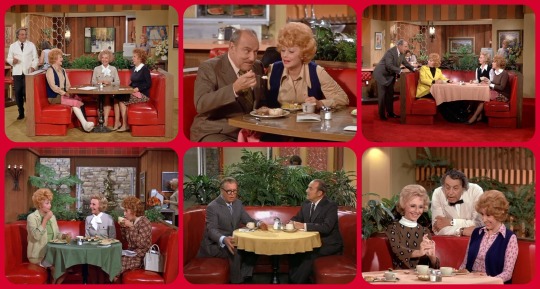
Bradshawe Building Coffee Shop
The Unique Employment Agency was located in the Bradshawe Building in Los Angeles, which had its own coffee shop, complete with counter service, booths, and tables. The eatery was featured in several episodes. Sid Gould played the regular waiter.
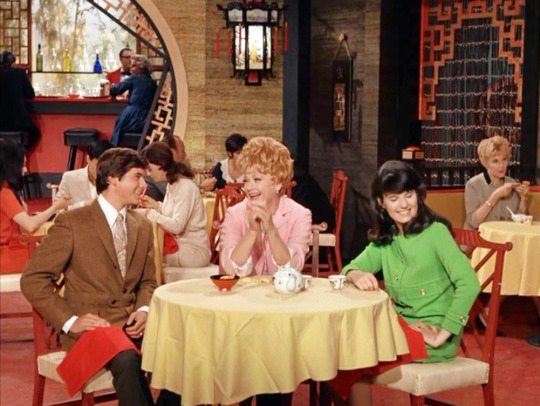
Yang Sing Ching ~ “Lucy’s Birthday” (1968)
Kim and Craig take their mother out to dinner at a Chinese restaurant. The (unseen) proprietor is named Irving. They even have matzoh ball soup on the menu. The waiters sing “Happy Birthday” to Lucy in Chinese.
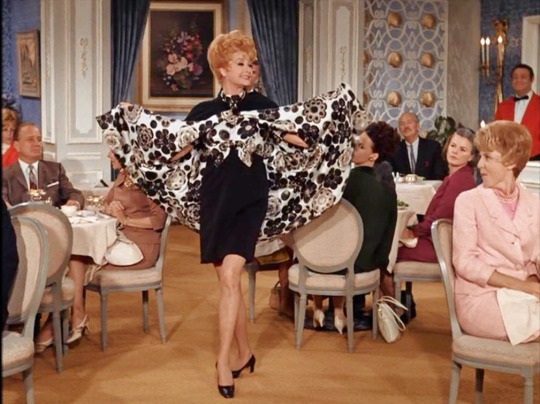
Pierre’s Restaurant ~ “Lucy’s Working Daughter” (1968)
To help Kim with her new job at a dress shop, Lucy turns fashion model, crashing a luncheon sponsored by Modern Miss Boutique.

The Theme Room at LAX ~ “Lucy and the Great Airport Chase” (1969)
The Carters have lunch at Los Angeles International Airport (LAX) inThe Theme Room (later named Encounter), a circular restaurant located atop the iconic Theme Building.
HARRY: “That was an excellent meal. Those were the best sand dabs I’ve ever had.”
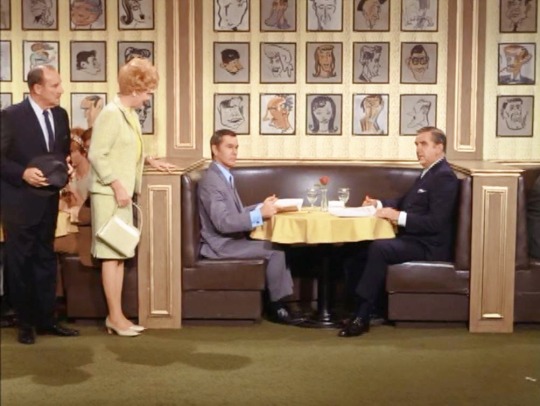
The Brown Derby ~ “Lucy and Johnny Carson” (1969)
After playing Stump the Band on “The Tonight Show” Lucy wins a dinner for two at the Brown Derby. There she runs into Johnny and Ed McMahon. In an homage to the classic “I Love Lucy” episode also set at the Brown Derby, Lucy manages to cause a tray of drinks to be spilled on Carson.
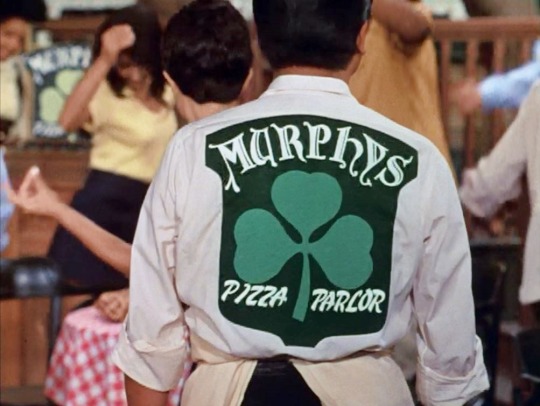
Murphy’s Pizza Parlor ~ “Lucy and the Generation Gap” (1969)
The episode opens with Kim, Craig and their friends planning the school musical at a pizza place operated by an Irish Asian named Murphy Irving Wong (Victor Seng Yung).
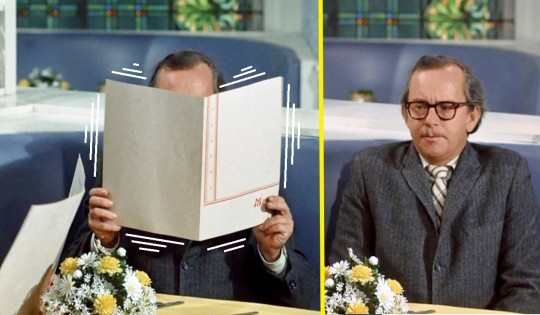
Café George ~ “Lucy and Wally Cox” (1970)
Lucy agrees to meet the son of Harry’s friend, Wally, who is afraid of girls. Harry also meets his father and old friend Moose at the same restaurant.
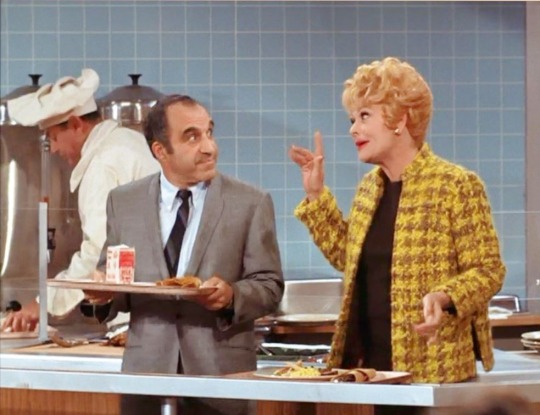
Cafeteria ~ “Lucy Competes with Carol Burnett” (1970)
Lucy and Carol meet at a cafeteria for lunch, where they plan to enter the Secretary Beautiful Contest representing their respective workplaces.
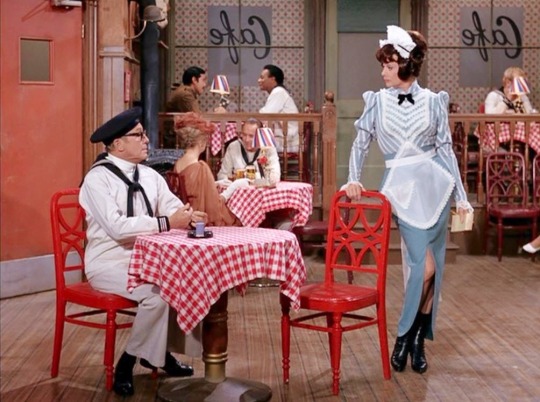
Café ~ “Lucy and Jack Benny’s Biography” (1970)
Lucy recreates all the women in Jack Benny’s life. In the second flashback, set in 1915, Jack is in the navy and is smitten by Zelda (Lucy), a waitress at a café.
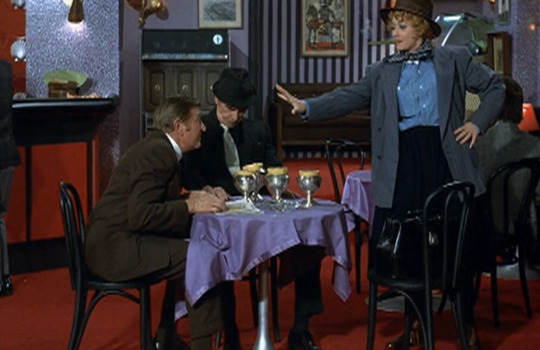
The Red Devil ~ “Lucy and Ma Parker” (1970)
Lucy impersonates a femaile master criminal, confronting mobsters Joe Grapefruit and Muggsy at the Red Devil, which is mostly a bar, but also serves grapefruit!
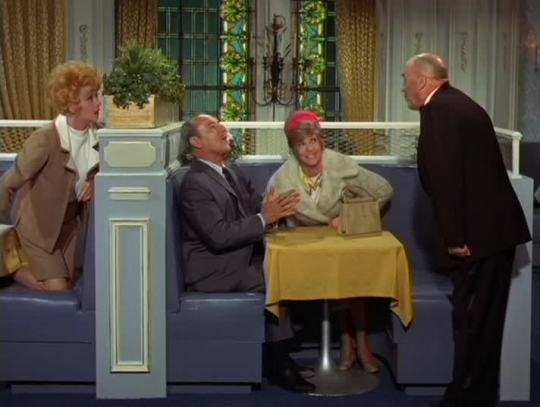
Chez Moi ~ “Lucy Stops a Marriage” (1970)
At a French bistro, Lucy spies on Harry when he dines with Laura Trenton (Jayne Meadows), believing he is headed to the alter. Harry order imported champagne - imported from Fresno!

Waikiki Dining Room on the S.S. Lurline ~ “Lucy Goes Hawaiian: Part 1″ (1971)
Lucy volunteers to assist Harry as cruise director on a ship bound for Hawaii. Viv, Kim and Craig come along. Although recreated on the Paramount lot, the ship was real, as was the Waikiki Dining Room.
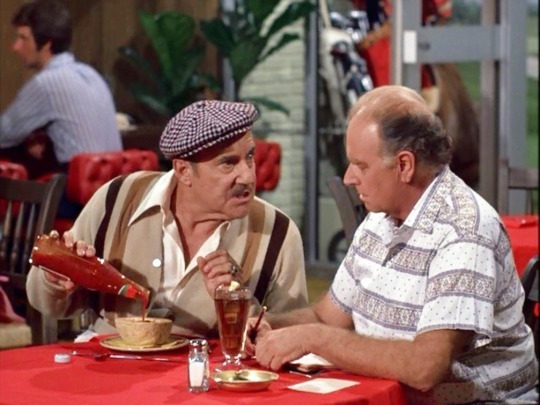
Country Club Restaurant ~ “Lucy’s Bonus Bounces” (1971)
Harry meets his analyst Dr. Cunningham (Parley Baer) at the Country Club for lunch. Cunningham orders an iced tea and Harry has half a cantaloupe - which he absent-mindedly pours catsup on!
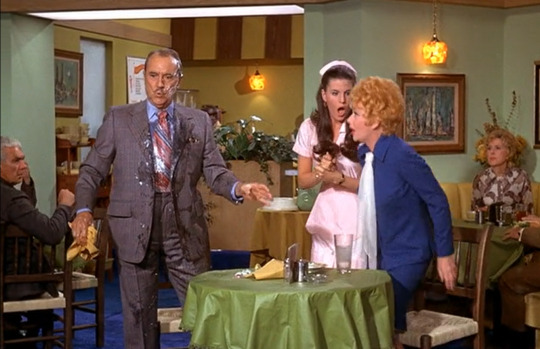
Harry’s Favorite Restaurant ~ “Lucy Makes a Few Extra Dollars” (1971)
To teach Harry a lesson, Lucy takes Harry to lunch and has Kim wait on him. She is making 40 cents an hour. Lucy orders a hamburger and iced tea. Harry’s usual is a salad - which Kim spills all over him - deliberately. She then dumps an ice cold glass of iced tea in his lap!
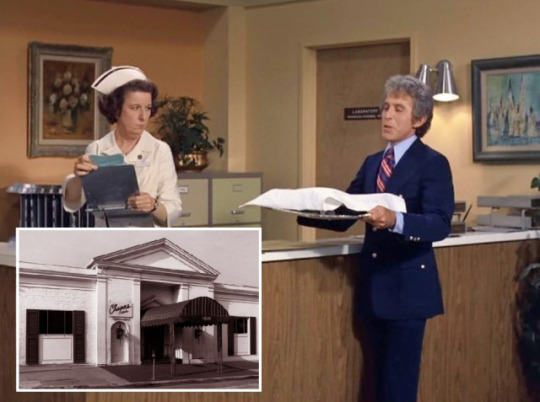
Chasen’s ~ “Lucy and Eva Gabor are Hospital Roomies” (1972)
In the hospital Gabor’s assistant Walter (R.G. Brown) brings Gabor's dinner on a silver tray. He says it was prepared especially for her by Chasen's, a real-life West Hollywood restaurant frequented by entertainers. It first opened in 1936 and closed for good on April 1, 1995. Lucille Ball and Desi Arnaz were regulars and had their own private booth there. Although it is mentioned, no scenes are set there.

Schwab’s Drug Store ~ “The Case of the Reckless Wheelchair Driver” (1972)
Kim says she saw Billy Joe Jackson (Jim Bates) at Schwab's. Schwab’s Pharmacy was a drug store located on Sunset Boulevard and was a popular hangout for wannabe movie actors from the 1930s through the 1950s. Schwab’s also had a soda fountain serving ice cream and light meals. It is Hollywood legend that actress Lana Turner was discovered at Schwab’s. Schwab’s closed its doors in October 1983 and five years later was demolished. Schwab’s was mentioned on “I Love Lucy” in “Lucy Wants to Get Into Pictures” (1955).

Hotel Showroom ~ “Lucy and Donny Osmond” (1972)
Lucy’s niece Patricia (Eve Plumb) is a Donny Osmond fan. He is performing at the Hotel Showroom where he later orders a peanut butter and jelly sandwich and a glass of milk, even though the chef reccommends the escargot (snails). As a souvenir, Lucy takes the menu... and the ashtray... and the matches... and the flowers... and the vase... and the sugar cubes!
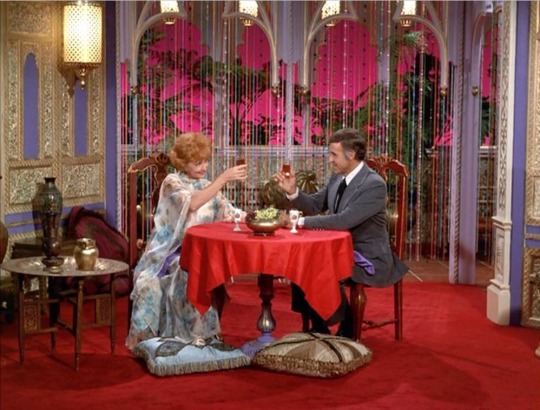
Persian Restaurant ~ “Lucy and Her Prince Charming” (1972)
Lucy is dating a handsome man (Ricardo Montalban) who turns out to be royalty. When Harry finds out that the Prince is in love with Lucy, he'll stop at nothing to get the two married - including masquerading as a fortune teller during their date at a Persian-themed restaurant.
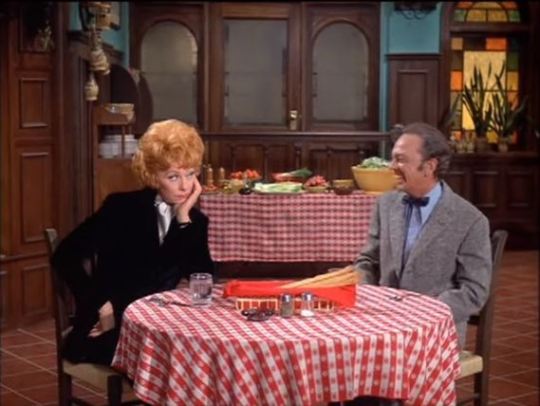
Villa Roma ~ “Lucy’s Last Blind Date” (1973)
When Harry finds out his cousin Ben (Don Knotts) is rich and single, he wants Lucy to go on a blind date with him.
BEN (to Lucy, about the menu): “I don’t know if you’ve noticed, but this is all in a foreign language.” LUCY: “It’s Italian. You kinda have to expect that in a restaurant called the Villa Roma.”
Much of the episode also takes place at the Bradshawe Building Coffee Shop (see the first entry above).
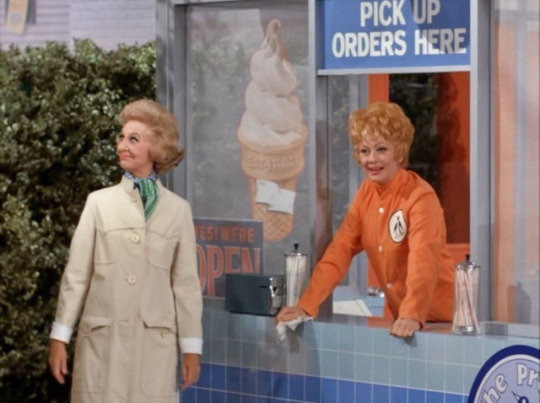
The Proud Penguin ~ “Lucy and the Franchise Fiasco” (1973)
The Proud Penguin is a frozen custard stand on Citrus Boulevard across the street from the Los Angeles Zoo. Lucy and Mary Jane are partners in the business, The episodes also features scenes set in the Bradshawe Building Coffee Shop and on the dining terrace of the Westland Country Club, where a dinner of a whole albacore tuna is destroyed by baby penguins!
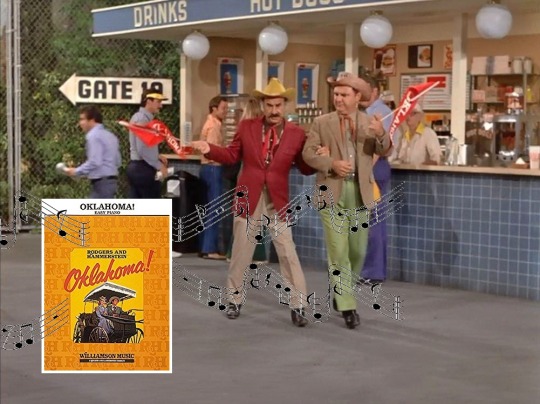
Refreshment Stand at Los Angeles Memorial Coliseum ~ “Lucy and the Big Game” (1973)
Lucy and Harry recieve tickets to a football game between the USC 'Trojans’ and the University of Oklahoma 'Sooners’. Two visiting team fans (Cliff Norton and Al Checco) pass by singing the title song of the Rodgers and Hammerstein musical. Although the Coliseum is a real place, the gate area was recreated on a Paramount soundstage.
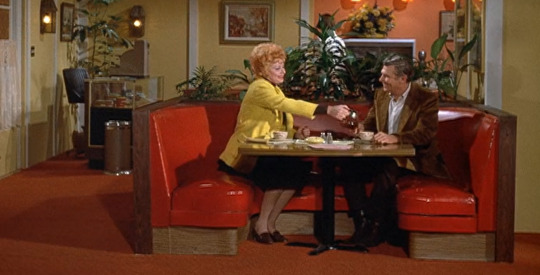
Restaurant ~ “Lucy and Andy Griffith” (1973)
Lucy has coffee with Andy Johnson (Andy Griffith) to talk about his work with underprivileged youth. In the next scene, Kim and Harry meet at the same restaurant and sit in the same booth! The red booths used in the episode were also seen in the Bradshawe Building Coffee Shop.

Dirty Jack’s Paradise Café ~ “Where is My Wandering Mother Tonight?” (1974)
While staying with Kim at her new apartment, Lucy decides to give her and her boyfriend some alone time and visits a nearby tropical-themed café where she drinks coffee and talks to the owner (Jack O’Brien). The famous red booths are back!
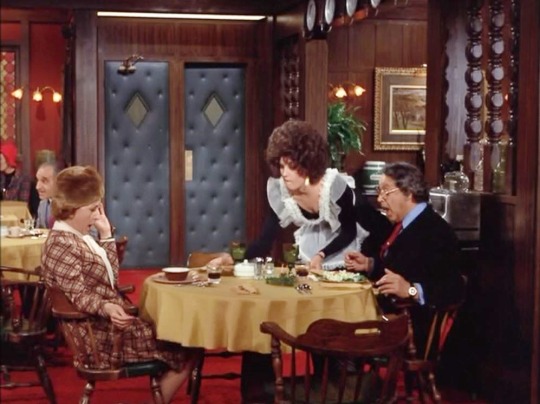
Harvey’s Welcome Inn ~ “Lucy Fights the System” (1974)
To prove that a waitress Mary was let go because of her age, Kim goes undercover as a new hire. She deliberately turns the restaurant upside down to prove how capable Mary was. This is the last episode of the series. Fittingly, Harry gets a pie in the face.
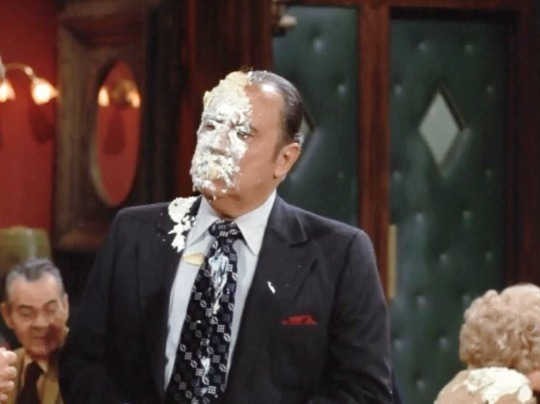
“I knew it would end like this.”
#Lucille Ball#Dining Guide#Gale Gordon#Here's Lucy#Lucie Arnaz#Desi Arnaz Jr.#tv#Jack O'Brien#Restaurants#Diner#Coffee Shop#Mary Jane Croft#Andy Griffith#Don Knotts#Wally Cox#LAX#Ricardo Montalban#Eve Plumb#Donny Osmond#Sid Gould#Vanda Barra#Johnny Carson#Ed McMahon#Chasen's#Brown Derby#SS Lurline#Jim Bates#R.G. Brown#Eva Gabor#Jack Benny
4 notes
·
View notes
Text
28. Alls Wellford That Ends Willy with Matt Gourley
Plot summary:
Two long shore men on their very first day, Dutch and Mac, meet Wellford, Crime Job Savior, Nickname: Willy who steals crime jobs from criminals. She warns them that their jobs are going to be stolen but that she'll get them back. Dutch and Mac go to the bar for pickled eggs and Irish Car Bombs because they're out of a job now. A nine year old boy dies of alcohol poisoning in front of them and Bruno and Paulie, two mobsters , come to steal the bartenders job. In the manor of Baron von Tingles, Baron and Baroness beat their butler Rufus with a variety of switches labeled by days of the week. He's then adopted by the Tingles. Bruno and Paulie interrupt the adoption and demand to be adopted as well because they've stolen Rufus's job. They're adopted even though they're not good at singing Tingle Jingles. Willy starts a revolution and has the will to do well for the townspeople. The townspeople help her by tricking the mobsters into the bar with help wanted signs. Mr David Misterman, the leader of the mob and Willy's identical twin brother, shows up to the bar with his cronies who have recently been reading books about bartending. Willy takes his job instead using the power of her estranged mother. She gives them all jobs so they don't have to steal anyone else's. She then fires them and wins the battle. Then they get jobs and are all adopted by the Tingles and Mac asks Willy out for cocktails.
Best quotes:
• "WHISKEY FOR CHILDRENNNNN WHATS IT GONNA DO, KILL EM?"
Best songs:
• Vodka and Whiskey
Thoughts Overall:
Welcome to Off Scroll with William and Ruth! This episode starts with a discussion about middle names. Jess was named after her great great grandmother who ran a psych ward and Zach also had a great grandmother named Ruth who ran a psych ward. I have no idea what even happened in this episode but Matt Gourley is great
#off book ep 28 alls wellford that ends willy with matt gourley#matt gourley#off book podcast#jess mckenna#off book#zach and jess#zach reino#jessica mckenna#zachary reino#play it by ear#z&j
0 notes
Text
I'm thinking about it and I think BBC Merlin may have the worst character development of minor characters (and some major ones, Arthur sweetie you deserved consistent characterization) of any show I have ever watched. I have watched shows intended for young kids do minor character development better than bbc merlin, that's how shit they were at it. Like, its not hard to make minor characters be actual characters that are fleshed out, it doesn't even take that much time. I've seen one episode characters in Leverage be more fleshed out than some Merlin minor reoccurring characters
#bbc merlin#merlin#liv talks merlin#like the irish mob guys from the boys night out job those fuckers somehow managed to be more fleshed out than at least percival and#their dynamic managed to feel more fleshed out or as fleshed put at the dynamic between leon and gwaine#the mobsters were in ONE episode of leverage#leverage#leverage is a fantastic show yall should go watch it
30 notes
·
View notes
Text
I would like for Discovery to give in to the time-old Star Trek tradition of “we’re tired of being a sci-fi show so for one episode we’re going to be 1940s mobsters/victorian detectives/1800s Irish villagers/WWII resistance fighters/1960s spies/wild west gunslingers.”
#dis#txt#spectre of the gun#fair haven#out man bashir#elementary dear data#a piece of the action#the killing game#tos#tng#voy#ds9
1K notes
·
View notes
Text
"The Great Boldini"

Season 3, Episode 38
First US Airdate: December 11, 1989 First BBC UK broadcast: March 9, 1992
The Turtles are blamed when Don Turtelli steals a valuable emerald.
"The Great Boldini" is the thirty-eighth episode of Teenage Mutant Ninja Turtles season three. This episode is written by Francis Moss, whose last episode was "Invasion of the Turtle Snatchers" earlier this season.



Michaelangelo is performing a magic show for the other Turtles, who drag him the entire time as he fails to successfully perform any tricks. He’s accompanied by the returning Zach from “The Fifth Turtle”, and Caitlyn, a second irritating kid character debuting here. Zach mentions that it’s time for a show by magician The Great Boldini at the museum; Michaelangelo sourly wonders what Boldini has that he doesn’t.

At the same museum, April interviews curator Doctor Fishbein regarding the unveiling of the Tortellini Emerald, who isn’t able to provide much in the way of useful information about it as he’s a palaeontologist.



The Turtles travel to the museum and the kids greet April; Zach explains that Caitlyn wants to be a Turtle too, and she goes on to correct him, saying that “I want to be a Turtle like you, Miss O’Neil.” Donatello (represented by Leo due to an animation error) explains that “April’s more of an associate Turtle”. Raph suggests that she’s on the verge of being promoted over Michaelangelo, who’s really getting dragged by the others in this episode.


Later, April films a live report as The Great Boldini prepares to make the Tortellini Emerald disappear. Watching all this on TV is the returning Don Turtelli and his underling Rodney, both of whom apparently were released by the police following their previous appearance in “Case of the Hot Kimono”. The mobster explains that the emerald originally belonged to his grandfather, Tony “The Tickler” Turtelli, who only lost it because “the police caught him coming out of the museum with it”. Ominously, he tells Rodney that the family will own it again.


The Turtles – not wearing their human masks – and the kids watch Boldini perform his trick alongside a crudely-drawn audience. The lights dim, and when they come back up, the emerald is gone, while Boldini is tied up. Guards rush to untie the magician, who cries that someone restrained him before he could finish the trick, and the emerald has in fact been stolen.




Doctor Fishbein orders that everyone in attendance be searched, putting the Turtles in an awkward situation. Leonardo orders Zach and Caitlyn to head to the control room with April. On their way there, the kids spot Boldini exiting through a door and track him as he enters a storage room. They watch as Boldini recovers the emerald from a pipe and presents it to Don Turtelli, who’s revealed to be his cousin. Turtelli helpfully goes on to explain he had one of his construction companies set up the framework for this robbery, as well as a sewer escape route. Caitlyn intervenes, snatching the emerald from the crook’s hands.


Above ground, the site of the robbery is investigated by Lieutenant Fronski and Irish New York cop stereotype Sergeant O’Flaherty. The officers confront April, who tries to provide cover by saying the Turtles are with her, but without success. Raph declares that he hopes this won’t require a strip search, as “this is a family show”.



As Turtelli and Boldini corner Zach and Caitlyn below ground, the Turtles have their disguises removed in the museum. The police draw guns on the team as we head into our first commercial break.



Zach is able to snatch the emerald, but Tortelli captures Caitlyn. He offers to do a trade, and declares that if the boy doesn’t comply, Caitlyn will suffer the consequences before revealing his trademark feather.
vimeo


In the museum, things go off the rails as O’Flaherty really leans into the Irish cop bit. (Michaelangelo describing himself as a four-foot-tall turtle is definitely an odd bit of dialogue here, given that most sources during this era have them all as being closer to five feet). The team use his bafflement at being confronted by what he thinks are leprechauns to his advantage, leaping into the air and escaping. They make their way outside, borrowing April’s news van with the police not far behind.


The stand-off continues between Zach and Turtelli, with the boy eventually agreeing to hand over the emerald when the Rat King of all people emerges. He’s furious that the mobster has built tunnels on what he considers to be his domain, and demands compensation in the form of the emerald. While the villains have been squabbling, however, Zach and Caitlyn have escaped with the jewel.



Rat King suddenly becomes a lot more cooperative, agreeing to work with Turtelli to locate the children for a price. He sends his rats to scare everyone out of the museum, then has them chow down on the circuit boards in the building’s security system which improbably locks down the entire premises.


Having escaped back to the lair, the Turtles return to the museum after learning Zach and Caitlyn are trapped inside. They reunite with April and discover a “Turtelli Museum Remodeler” van parked nearby. Inside, Turtelli uses feather torture to try and make the kids reveal the location of the emerald as the second act ends.



Act three opens with the Turtles discovering a hole in the floor of Turtelli’s van leading into the sewers. Before they can investigate further, they’re confronted by Sergeant O’Flaherty. The team eventually convince him to provide them with one hour to solve the case, offering to turn themselves in if they fail. April gives the Sergeant a kiss on the cheek for his help.



Rat King can’t face watching Turtelli’s continuing interrogation of Zach and Caitlyn, and heads off to collect some “artsy stuff” from around the museum for his sewer home. After a brief but fun sequence in which he gets a second opinion on some paintings from his rats – who are only receptive to a depiction of some cheese – he's confronted by the Turtles, and flees to the control room. There, his rats chew on some more circuitry, which somehow causes the building’s climate controls to switch things up and create blizzard-like conditions. I’m not sure how or why the systems would be capable of doing that, but here we are.



Zach finally gives in, providing Turtelli with the emerald as the blizzards kick in. The kids are able to make their escape, but the crooks at least have what they came for. The Turtles trudge through the snow before reuniting with their young friends. They go on to confront Turtelli and Boldini, both of whom are struggling to find their escape route.




As a snowball fight breaks out in the basement, Donatello and Caitlyn work to implement a replacement climate system in the control room. Meanwhile Michaelangelo and Zach discover a case of magic tricks, and use them to retrieve the emerald before capturing both Turtelli and Boldini. With the security systems now working again, April and O’Flaherty help the Turtles escape. In a news report, the Sergeant credits the arrests in part to “The Teenage Mutant Ninja Leprechauns”. Back in the lair, Michaelangelo dances a jig on a coffee table to round things out.
You may recall that I was scathing about Zach’s first appearance in “The Fifth Turtle”, an episode that had fairly great animation coupled with a routine Shredder/Krang crystal theft plot, all of which was burdened by the presence of this new insufferable kid character. "The Great Boldini" takes any redeeming qualities of that episode and throws them out the window, adding both a second annoying kid, Catliyn, and mediocre production values to the mix. Throw in mediocre midcard villain Don Turtelli and his cousin, and even a fleeting appearance by Rat King isn’t enough to save things. Sergeant O’Flaherty’s antics raised a laugh in a “I can’t believe they’re leaning this far into the bit” kind of way, but otherwise this is a standard-length Turtles adventure that feels like it drags on for about three hours.
This is the final appearance of Don Turtelli – who presumably was arrested for good this time, alongside Boldini, who won’t be returning either. Rat King will be back next season in “Were-Rats from Channel 6”. Caitlyn, whose character never managed to amount to much more visually or in terms of writing than “Girl Zach”, never appears again.
NEXT TIME: Zach returns in “The Missing Map”, because life is often unfair. At least there’s only one of him now.
#Teenage Mutant Ninja Turtles#TMNT#TMNT 1987#1989#The Great Boldini#Don Turtelli#Turtlethon#Rat King#The Rat King#Ninja Turtles
4 notes
·
View notes
Link
In a slightly different world, Fargo season 4 might never have happened. After the FX anthology drama ended its third season, creator Noah Hawley admitted that he didn’t have an idea for a follow-up. And, he figured, “the only reason to do another Fargo is if the creative is there.” So, if there was to be a sequel, Hawley estimated it would take three years. That was in June 2017.
Thirty-nine months later (it would have been 34 had COVID not temporarily halted production), the show has reemerged with a story whose timeliness is obvious. It marks a significant departure from the earliest seasons of Fargo, which pitted good and evil archetypes against each other in arch, violent crime capers that ultimately erred on the side of optimism. Season 3 flirted with topicality, from an opening scene that hinged on Soviet kompromat to a hauntingly inconclusive final showdown between the latest iterations of pure good—represented by Carrie Coon’s embattled police chief Gloria Burgle—and primordial evil (David Thewlis’ terrifying V.M. Varga). Five months into Donald Trump’s presidency, that ending simultaneously reflected many Americans’ fears for the future and suggested that the battle for the human soul would be an eternal one. You can imagine why Hawley might have considered it a hard act to follow.
Instead of trying to top the high-flown allegory of its predecessor, the fascinating but uneven new episodes tackle conflicts of a more earthly nature: race, structural inequality, American identity. To that end, Fargo season 4 ventures farther south and deeper into history than it has gone before, to Kansas City, Mo. in 1950. For half a century, ethnic gangs have battled over the midsize metropolis. The Irish took out the Jews. The Italians took out the Irish. Finally, just a few years after a brutal World War in which fascist Italy numbered among the United States’ enemies, the Great Migration has brought the descendants of slaves north to this Midwestern city whose complicity in American racism dates back to the Missouri Compromise.
This upstart syndicate is led by one Loy Cannon (Chris Rock in a rare dramatic role), a brilliant, self-possessed power broker who doesn’t relish violence but is determined to exact reparations from this country, on behalf of his beloved family, by any means necessary. Loy’s deputy and closest friend is a learned older man by the name of Doctor Senator (the great Glynn Turman, all quiet dignity). In an early episode, the two men walk into a bank to pitch its white owner on an idea they’ve been testing out through less-than-legal means in the Black community: credit cards. (“Every average Joe wants one thing: to seem rich,” Loy explains to the banker.) He turns them down, of course, convinced that his clientele would have no interest in purchasing things they couldn’t afford. We’re left wondering how the ensuing saga might’ve been different if Loy and Doctor Senator had been allowed to channel their considerable intelligence into a legit business.
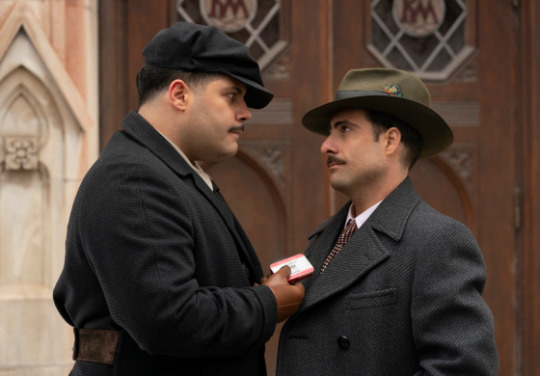
Elizabeth Morris/FXSalvatore Esposito and Jason Schwartzman in ‘Fargo’
The Italians, meanwhile, are starting to enjoy the rewards of their newfound whiteness—a largely invisible transformation marked in The Godfather by Michael Corleone’s relationship with naive WASP Kay Adams. (In keeping with previous seasons’ allusive style, Fargo often playfully evokes Francis Ford Coppola’s trilogy.) In the wake of their capo father Donatello’s (Tommaso Ragno) death, two brothers battle for control of the Fadda clan—a crime family that has Italian-accented patriarchalism written into its very name. Crafty, spoiled, crypto-corporate Josto (Jason Schwartzman, doing a scrappier, cannier take on his Louis XVI character in Sofia Coppola’s Marie Antoinette) has long been Donatello’s right hand. But his younger brother Gaetano (Salvatore Esposito, imported from Sky Italia’s acclaimed organized-crime drama Gomorrah), a brawny brute who came up in Sardinia busting heads for Mussolini, stands between Josto and the consolidation of power.
Generations-old tradition dictates that if two syndicates are to share turf in Kansas City, their leaders must raise each other’s sons. These exchanges are supposed to be a sort of insurance policy against betrayal; never mind that they never work out as planned. So Loy very reluctantly trades his scion Satchel (Rodney Jones) for Donatello’s youngest (Jameson Braccioforte). The boy finds a protector in the Faddas’ solemn older ward, Patrick “The Rabbi” Milligan (Ben Whishaw, humane as always), who double-crossed his own Irish family in an earlier transaction.
Ethelrida Pearl Smutny (E’myri Crutchfield from History’s 2016 Roots remake) is the show’s other innocent youth, a bright and insightful Black teenager whose parents (Anji White and indie rocker Andrew Bird) own the poignantly named King of Tears funeral home. Every Fargo season needs a personification of goodness, and in this one it’s Ethelrida. Not that her virtuousness makes her life any easier. In a voiceover montage that opens the season premiere, she tells us that she learned early on that, as far as white authority figures were concerned, “the only thing worse than a disreputable Negro was an upstanding one.” Her inscrutable foil is Oraetta Mayflower (Jessie Buckley), a white nurse neighbor whose patients tend to die before they can experience too much pain. Oraetta’s quaint Minnesota accent (another Fargo staple) belies the racist views she politely but unapologetically espouses; she seems fixated on making Ethelrida her maid.
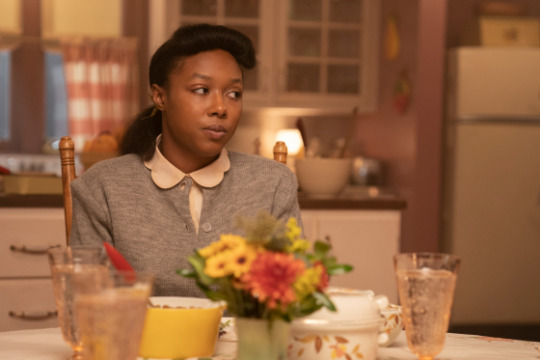
Elizabeth Morris/FXE’myri Crutchfield in ‘Fargo’
It’s fitting that Oraetta is both the most tangible link to Fargo’s home turf and the first character who ties together the mobster’s story with that of the Smutny family. As her loaded last name suggests, she seems to embody a particular form of evil that has been a constant in American life since the colonial period: white supremacy. Oraetta harms, kills and plunders with minimal consequences. No wonder she has eyes for Josto, the first Fadda who knows how to wield his white identity, building alliances with government and law enforcement that would be impossible for the Cannon syndicate. (Josto’s version of Kay Adams is the homely daughter of a politician.) “I can take all the money and pussy I want and still run for President,” he boasts at one point.
The reference to our current President’s briefly scandalous Access Hollywood tape is so flagrant as to elicit an involuntary groan. It’s lines like this that expose the limitations of Hawley’s attempt to fuse the topical and the elemental. Fargo still creates an absorbing, cinematic viewing experience, with painterly framing, pointedly deployed split-screen and arcane yet evocative needle drops. A not-at-all-gratuitous black-and-white episode could almost stand on its own as a movie. And, as in past seasons, the show gives us many remarkable performances: Rock may seem an odd pick for a gangster role, but the same shrewdness and indignation that fuel his stand-up persona also simmer beneath Loy’s measured surface. The pain Whishaw’s character carries around in his body goes far beyond what can be conveyed in dialogue. Bird broke my heart as a meek, loving dad. But in his eagerness to make a legible, potent political statement, Hawley struggles to find the right tone and keep the season’s many intersecting themes straight.

Elizabeth Morris/FXJessie Buckley in ‘Fargo’
The show is simply trying to do too much within a limited framework. Fargo wouldn’t be Fargo without some eccentric law enforcement, so an already-huge cast expands to fit a crooked local detective with OCD (Jack Huston) and Timothy Olyphant—whose roles on Deadwood and Justified made him prestige TV’s quintessential cop—as a smarmy, Mormon U.S. Mashal who snacks on carefully wrapped bundles of carrot sticks. Yet Hawley also realized that he needed to break from previous seasons that, like the Coens’ film, cast a white police officer as the avatar of goodness; hence Ethelrida, whose investigation into her city’s criminal underworld takes the form of a school assignment, and whose soul is stained by neither corruption nor white privilege. She’s a wonderful character, but her and Oraetta’s story line can feel peripheral to the gang war.
With such a crowded plot, it’s no wonder the show can’t maintain a consistent tone. Each season of Fargo creates a hermetically sealed moral universe, doling out divine and definitive justice to each character according to their position on the spectrum spanning from good to evil. In the past, its archness has served as a self-aware counterbalance to the sanctimony inherent in such a project. And there’s still plenty of irreverence in season 4, particularly when it comes to Hawley’s depiction of the Faddas, Oraetta and the other white characters. But there’s nothing funny about the oppression and discrimination that Loy, Doctor Senator and Ethelrida face. Each of their fates is shaped at least as much by a society that is hostile to people who look like them as it is by the moral choices they make as individuals. So the scripts give them the dignity they deserve at the expense of inflicting earnestness—along with frequent reminders, such as Schwartzman’s Trump line, that the story’s themes remain relevant today—on a format that isn’t built for it. Realistic characters and absurd ones awkwardly mingle.
Hawley’s attempt to correct his show’s political blind spots is laudable, and some pieces of the allegory work well; the ritual of ethnic gangs trying—and failing—to work together by raising each other’s sons makes an inspired metaphor for America’s fragile social contract. Even so, Fargo seems fundamentally ill-equipped to address systemic inequality. Though that failing may well render future seasons similarly flawed, if not impossible, in our current political climate, it doesn’t negate the pleasures or insights of what remains one of TV’s most ambitious shows. Like this nation, the new season is a beautiful and ugly, inspiring and infuriating, a tragic and sometimes darkly hilarious mess. As frustrating as it often was to watch, I couldn’t look away.
2 notes
·
View notes
Photo


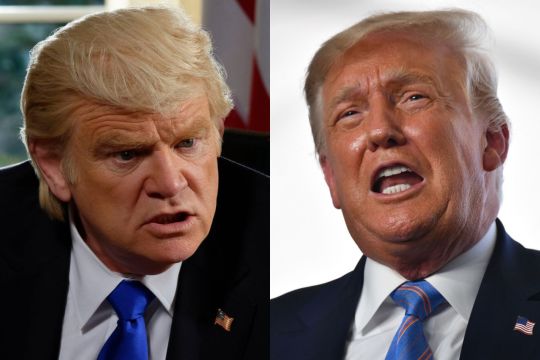
Review: ‘The Comey Rule’ and What a Fool Believes
Showtime’s political drama is a scattered but searing picture of failed self-righteousness. By James Poniewozik Sept. 24, 2020
The thing that James Comey will probably like best about “The Comey Rule,” if one believes its characterization of him, is that his name is in the title.
But he is not exactly the hero. He is not even, really, the star.
Comey (Jeff Daniels), the former F.B.I. director, gets more screen time than anyone else in Showtime’s two-night, three-and-a-half-hour special. But the real lead is Donald Trump (Brendan Gleeson), in the same sense that, regardless of its minutes on camera, the true lead of “Jaws” is the shark.
Given how much it rehashes recent events, albeit with a fine cast, I’m not sure what interest “The Comey Rule” will have beyond people whose copies of the Mueller Report are already well thumbed. (There’s more to be learned from “Agents of Chaos,” the chilling Alex Gibney documentary, which premiered on HBO this week, about Russia’s 2016 election influence campaign and its American enablers.)
But if you stick to the end, there is at least a lesson and a warning, if not the one that Comey — either the screen version here or the real-life one who’s become a media figure — intended.
In his book “A Higher Loyalty,” he appears to see his decisions, which very possibly swung the 2016 election and failed to keep the president from interfering in investigations, as noble if tragic acts of principle. As translated by the director and screenwriter Billy Ray, this is instead a slo-mo horror story, in which the worst lack all inhibition while the best are full of fatuous integrity.
The first half, which starts Sunday, is basically a prelude. It walks us through the role of the F.B.I. in 2015 and 2016 when it investigated Hillary Clinton’s use of a private email server — with Comey making unusual public statements that damaged her campaign — while also looking, much more quietly, into increasingly disturbing signs that Russian intelligence was out to help Trump.
The first two hours blitz through the timeline and establish key players. So many familiar faces captioned with headline names pop up — Jonathan Banks as James Clapper! Holly Hunter as Sally Yates! — that it plays like a long, stone-cold-sober episode of “Drunk History.”
Daniels is inspired casting. Physically, he resembles the real Comey somewhat in stature (the ex-director still has a few inches on him). But having played figures of high-minded duty in “The Newsroom” and “The Looming Tower,” he captures his character’s starched righteousness wholly.
This time, however, there’s an ironic spin on the character. Comey’s actual rectitude is complicated by his fixation on the appearance of rectitude, his homey decency by smugness.
His precedent-breaking decisions to speak out on Clinton’s email practices were driven by worry over how he and the bureau would look later if — in his view, when — she became president. (He writes in “A Higher Loyalty” that he assumed she’d win.)
His guess proves wrong, but the day after the election he assures his devastated wife, Patrice (Jennifer Ehle), “We’re going to be OK.” True enough for him. He lost his job but wrote a best seller.
With that self-justifying memoir as a source, Ray makes the sharp choice to make Rod Rosenstein (Scoot McNairy), the deputy attorney general who wrote the memo recommending Comey’s 2017 firing, the quasi-narrator. Rosenstein bitterly introduces Comey as a self-righteous “showboat” (though, we discover, Rosenstein has his own blind spots and failings).
This is not, however, a production out to win over MAGA viewers. (At one point, it dramatizes one of the more eye-popping accusations of the Steele dossier.) The first night, we see Donald Trump only as shot from behind, a leering hulk parting the curtain at a Miss Universe pageant and pawing at a contestant’s bikini strap. He’s like the barely glimpsed monster in the first act of a creature feature, a rough beast slouching toward Pennsylvania Avenue.
It’s on Night 2, when President-Elect Trump emerges as a character, that the show really begins. In part, it’s simply that his crew of artless amateurs, relatives and B-list pols make for better TV. Not every portrayal works — Joe Lo Truglio as Jeff Sessions? — but it gives the proceedings a “Burn After Reading” flair.
But mostly, Gleeson kicks the program to life. Strictly as an impression, his performance is mixed. Gleeson, who is Irish, slips occasionally on the accent. But his rendering of Trump’s wandering diction is the best I’ve seen outside a lip-sync. Half his performance is in his bearing, chin jutted forward like the prow of a swollen yacht.
More important, Gleeson has a thorough idea of his character. His Trump is not the orange-haired clown prince of “S.N.L.” and late-night talk shows. He’s a crass, heavy-breathing mobster (Comey’s comparison, and Gleeson makes the likeness vivid) driven by spite and vanity. A heavy-handed musical score portends menace whenever he turns up.
He, too, is concerned with appearances, but in a more literal way than Comey. His version of “good morning” is “I saw you on TV”; he and his staffers keep referencing his “eye for interior design.” His brassy presence in the halls of power is as much an aesthetic statement as a political one, which Ray underlines by showing a White House staffer serving him a Filet-O-Fish sandwich on a gleaming silver platter.
All the while, it gradually settles on Comey that his new boss may not be an entirely scrupulous man. Their White House dinner — the “honest loyalty” scene, for Comey buffs — takes only a few minutes, but you could imagine it as an entire movie, “Frost/Nixon” style.
It’s like an uncomfortable date with a persistent suitor. Trump, cleaning out his ice-cream dish, pushes and prods on the Russia investigation, pressing his advances. A pained Comey guards and parries, finding ways to say things that resemble what the president wants to hear.
Comey survives that battle but loses the war. “The Comey Rule” is not out to damn him. It strains itself to sympathize with his falling into one impossible position after another, and it suggests that public life might be better if everyone in it were like James Comey.
But it also shows how catastrophically inadequate he was to a world in which not everyone is like James Comey. He becomes a stand-in for an entire class of Trump-era elites who believe that respect for norms will save them. (The president “can’t fire me,” Comey tells an associate. “It’d look horrible.”)
As for Donald Trump, he’s not precisely the villain, in the show’s view. As “The Comey Rule” depicts him, he’s a creature, an appetite. He is what he is. He doesn’t know how to be otherwise.
Comey, on the other hand, is, if not a villain, then a tragic, hubristic dupe, precisely because he believes he knows better, and because he should.
“The Comey Rule” is not good drama; it’s clunky, self-serious and melodramatic. But it makes an unsparing point amid our own election season.
It says that anyone, like its subject, who complacently assumed in 2015 and 2016 that everyone would be fine, who thought that propriety and rules could constrain forces that care about neither, who worried more about appearances than consequences, was a fool.
Then it leaves you to sit with the question: What does that make anyone who still believes that today?
https://www.nytimes.com/2020/09/24/arts/television/review-comey-rule.html?action=click&module=RelatedLinks&pgtype=Article
THE COMEY RULE Trailer (2020)
Brendan Gleeson as Donald Trump
Jeff Daniels and Brendan Gleeson star as former FBI Director James Comey and President Donald J. Trump in this two-part event series that tells the story of two powerful men, whose strikingly different ethics and loyalties put them on a collision course. Watch the premiere on September 27 at 9/8c on SHOWTIME. #TheComeyRule #DonaldTrump
youtube
Brendan Gleeson portrays Trump as a crass mobster.
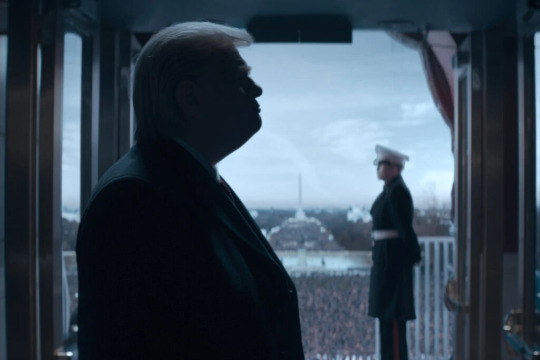
1 note
·
View note
Text
I’m over a decade late but I finished watching The Wire. The last episode finally features a Yiddish word when the lawyer Maurice Levy, who represents various drug kingpins throughout the series, invites his latest client Marlo over to his house for dinner because he’s now “mishpucha.”
Levy assimilates Marlo into the respectable world of capitalism. In this scene they’re both wearing suits and ties and Levy is networking with Marlo to help him engage in legitimate business opportunities.
This exchange wouldn’t be able to exist if Levy and his ancestors weren’t already assimilated. It wasn’t that long ago that Jewish mobsters were as infamous as Irish or Italian immigrants; the respectable profession of lawyering was formerly not open to Jews. But the assimilation into whiteness, the rise of the war on drugs and increased militarization of the police, austerity measures which saw the decrease in the power of some state institutions like social welfare and the simultaneous increase in power of courts and jails, has solidified the color line and made solidarity difficult. Levy is now part of the system that holds Marlo and other drug dealers trapped — not only figuratively where bourgeois law is concerned, but he and his colleagues literally rip off drug dealers. Omar made the comparison up front earlier in the show.
Assimilation into the white west is concomitant to the assimilation of political values. If “identity politics” can be coined by black socialist women but come to describe whatever it is Hillary Clinton does, then “Jewish social justice” can encompass everything from random progressive-sounding parts of the Talmud, to the orientalist non-profit industrial complex of 19th century Germany, to the bravery of Bundists or Jewish Freedom Riders. The actual, material assimilation of class is accompanied by a white-washing of history and ideology. “Not even the dead are safe” refers as much to literal dead bodies as it does their ideas and what they represent to living people.
The final season of The Wire also centers around a reporter, Scott Templeton, who has been falsifying stories and making up quotes. The show previously has shown the destructive forces of racist policing, austerity on schools, etc, but the final season has several scenes devoted to the ongoing wars in Iraq and Afghanistan. These scenes also concern the abuse of memory; but they also, perhaps more so than the episodes dedicated to policing, reveal the show’s unconscious nationalism.
Previous seasons of the show allow viewers to sympathize with victims of racist policing. In season five, however, while we sympathize with veterans who have been failed by their country upon returning home and ending up homeless and/or crippled, we never see the toll taken by those in Iraq or Afghanistan.
3 notes
·
View notes
Text
The Kitchen
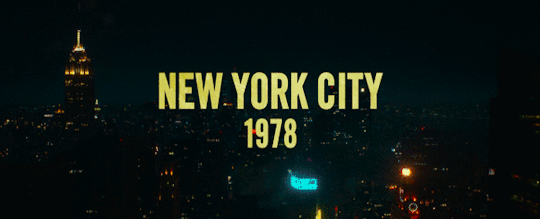
Oh guys. Ohhhhh you guys. It’s been awhile, you know? It’s been awhile since I’ve knowingly seen a film with less than, say, 30% on Rotten Tomatoes, but sometimes I can be convinced! Gimme a great cast and as long as the movie’s not trying to be a comedy I’m willing to give it the good ol’ college try because at least I can usually find something to laugh at. So I went into The Kitchen fully expecting a less-than-stellar but no doubt perfectly adequate time at the cinema. You’ve got Oscar nominee Melissa McCarthy, prestige TV darling Elizabeth Moss, and breakout charisma machine Tiffany Haddish as three women taking charge of their husbands’ mob empire in 70s Hell’s Kitchen? What could go wrong??? Well...
Imagine watching a montage of every 70s era mob movie you can think of. Got it? Got it firmly in your head? You have now had the experience of watching this movie. It’s like it’s 1993 again and you’re fighting with your sister over the remote and one of you hits the fast forward button while the smell of Bagel Bites drifts through the rec room and as you’re struggling to get the remote back, the movie is unspooling in front of you, incoherent images and sudden jerky movements, and your mom yells at you to stop fighting or she was gonna take the movie back to Blockbuster and NO ONE was gonna get to watch it. It’s like that, but unfortunately someone DID watch the movie, and that someone was me.
Some thoughts:
So first of all, I’d like to say that I enjoy Tiffany Haddish as a person. She seems like a real delight, and I think she’s working her ass off to get hers in Hollywood, which is fantastic and I wish her all the success in the comedy world. That being said. There’s uh...there’s a lot of eyebrow acting going on here. Just. So many eyebrows doing so many things. And a lot of nodding. People don’t nod this much in real life. She’s acting in scenes across from Oscar nominee Melissa McCarthy and usually that would tend to elevate a performance but for some reason, it’s all nods and eyebrows and I just think maybe gritty dramatic acting is not going to be her next successful career move.
It’s not just her though. All the bit parts and character actors they hired to fill out the Hell’s Kitchen neighborhood feel like they’re rejects from the first 10 minutes of a Law & Order episode. At one point, an old married woman says “Ain’t that right, Sal?” to her husband and he shushes her by swatting the air in front of him and grumbling “AAAAH.” THIS HAPPENS TWICE IN THE SCENE. I’ve seen termites that chew through scenery less.
The overacting? Forgivable. The weak script? I could handle it. But the pacing of this movie is so relentlessly awful that it almost feels like performance art. There are - I counted - 3 scenes that last longer than approximately 90 seconds. Just imagine it. You’re watching a movie. You like the actors. The story’s ok. But something seems off. You don’t know what. The costumes are good. The performances are ok. The music is great. But something is wrong. It’s definitely wrong. Do you feel it? Is it bothering you? Have you had enough yet? Are you yearning for a descriptive sentence, an appositive phrase, anything with even one fucking comma in it to indicate a complex thought? Congratulations, now you know what it’s like to watch a 102-minute film that feels like it took 3 hours.
Let it never be said that I can’t find the silver lining amongst this pile of dreck! Domnhall Gleeson is a goddamn delight as a slightly unhinged, sleepy eyed mob assassin who came back to Brooklyn cause he heard Elizabeth Moss’s husband was in jail. In between making googly eyes at her, there is what is by far the funniest, weirdest scene in the movie in which he methodically explains how to dismember the dead body of an attempted rapist currently residing in Elizabeth Moss’s bathtub. This scene may be my favorite black comedy short film of the year.
Related: it’s fucked up but Gleeson is upsettingly attractive in this movie. These feelings are made even more complicated, because when he first shows up, I thought he was Elizabeth Moss’s estranged brother. But then they started making out and for a second I was having some VERY confusing feelings.
One thing the movie has in its favor - the soundtrack, while obvious, is banging. It’s 1978, if you don’t have a killer soundtrack it’s like you’re not even making an effort.
There are a few other shining spots. Melissa McCarthy does a fine job with the material she’s given. Elizabeth Moss at least seems to be having fun. It’s really not the actors’ fault that first-time director Andrea Berloff simply had no idea what to do with them.
On a related tangent, I would just like to point out that a criticism that is always levied towards works of art created by women and POC and queer folks and any other minority is that people only think it’s good just because the person belongs to that particular group. Well, I’m going to point to this film every single time someone tries to pull that bullshit ever again - I’m sure Andrea Berloff was trying her best, and there may have been unseen drama going on with the studio or during the production that led to this frenetic pile of polyester, but the end result is not at all better just because she’s a woman. I wanted to like this, I really did, but a poorly made film is a poorly made film no matter who’s behind the camera.
Case in point - my favorite scenes in the movie have nothing to do with the main characters, but instead focus on a group of rival mobsters in Brooklyn, led by an oily and perfect Bill Camp. His tete a tete with our main ladies is one of the three scenes allowed to be long enough to be, you know, interesting. Plus, he has an entourage of other Brooklyn mobsters with him, including the Jersey Shore-lite guy that Ann Perkins makes out with during the Harvest Festival in Parks and Rec, who has my favorite line in the whole movie. When he’s explaining to Melissa McCarthy that there’s a hit out on her and the gals, he explains how he knew - “I was in a bar......lookin at some titties...when he asked me.” “Asked you what?” “To kill you.” It’s his wide-eyed good cheer and sheepishly boyish grin that really sells it. I’ve been laughing about it for days.
Margo Martindale might be one of this generation’s finest character actresses, but she can’t do a New York Irish mob accent for shit.
Did I Cry? Oh god no. I should have - there’s major character death all OVER the place. But nah. I was still laughing about the titties.
I hate that I know how good this could have been. These women deserved better, and there are tiny seeds of interesting ideas going on, but ultimately everything falls flat.
If you liked this review, please consider reblogging or subscribing to my Patreon! For as low as $1, you can access bonus content and movie reviews, or even request that I review any movie of your choice.
#119in2019#the kitchen#the kitchen movie#the kitchen 2019#the kitchen review#melissa mccarthy#tiffany haddish#elizabeth moss#Domnhall Gleeson#bill camp#margo martindale#movie reviews#film reviews
5 notes
·
View notes
Text
Laughs and Lulz (The Lollercaust)
So why'd DC Comics want an author, if I don't like Jewish people, my mother and stepmother having been victims of the Mossad and the Jewish print industry, my mother being robbed by doctors for Superman scripts and my stepmother being written as "Eric Cartman" relatives, prior to South Park being on air as officially labeled, just concepts related, since she was in the 3rd grade, forcing her to kill her husband or the family would die when she rearranged the series, "Baywatch", the nude beach episode with the fat woman, because she faked big on a concerned mother letter to the network prior to the show, and was a cheerleader, before they medicated her after her husband's death?
Jewish mobsters killed my mother, for the Mossad, out of Marlboro, through Chris Dumais.
I've been cranking you since Jar Jar Binks, an autistic kid named Adam Palmer, written as an alcoholic, since the 8th grade.
That was the first piece you pedophile fucks stole.
Do you get what Longshot, The Brow, Professor X, Dr. Psycho, any of them, are?
That's written research of you trying to figure out the Royal Irish?
Do hear me here, grinning?
Laughing, all day long, at the amount of money the Mossad's lost, writing autistic alcoholics, Jar Jar Binks, into combat training scenarios, for undercover work
Look at all that money, little Leonard Epstein flew out of a plane called his office.
The one who died in 9/11?
Zach Savell, Mike Giroux, and Matt Lennox, thought I was mentally ill from victory, at the Mossad undercover profiles being written from Qua'lor the Quarren, the first time I got high with them, near Downey Street, in the woods.
All the Mossad were trained to be barely functional retards drinking beer at a Nazi convention in Minnesota my mother got raped at.
There was no shot at stopping 9/11, retards, or winning anything ever again, Hollywood.
The MI-6's first mount, is the precipice, the victory, then nothing.
0 notes
Text
Five Favorite Episodes of "DAREDEVIL" Season Two (2016)

Below is a list of my favorite episodes from Season Two of "DAREDEVIL", the Marvel Netflix adaptation of the Marvel Comics hero, Daredevil. Created by Drew Goddard, the series starred Charlie Cox as Matt Murdock aka Daredevil:

1. (2.06) "Regrets Only" - When Matt Murdock aka Daredevil and former girlfriend Elektra Natchios face the Yakuza during a gala held by the corporation Roxxon, they come across evidence conveying the return of a lethal former. Meanwhile, Matt and his law partner Franklin "Foggy" Nelson risk their firm to ensure justice for the vigilante Frank Castle aka the Punisher. Their assistant Karen Page sees a different side of the latter.

2. (2.04) "Penny and Dime" - Karen uncovers shocking facts about the Punisher's identity. Meanwhile, the latter finds himself hunted by a powerful Irish mobster in Hell's Kitchen, who wants revenge for his son's death.

3. (2.11) ".380" - Karen starts working with Frank to bring down the mysterious heroin dealer, Blacksmith. Claire Temple quits her job as nurse, when the hospital's administration tries to keep her silent regarding the Hand's attack. Matt visits Madame Gao, the Hand crime lord, in order to get information on Blacksmith. Stick learns that his attempt on Elektra's life had failed and prepares to face his former protégé.

4. (2.09) "Seven Minutes in Heaven" - In Ryker's Island Prison, crime lord Wilson Fisk offers Frank a chance at Dutton, the prison's "kingpin", whom Fisk believes had organised the deal-gone-wrong that lead to the deaths of Castle's family; in order to become the prison's new "kingpin".

5. (2.08) "Guilty as Sin" - As Frank's trial spins out of control for Matt and Foggy, Matt's former mentor, Stick, returns to deliver shocking revelations about the future of Hell's Kitchen and that he is also Elektra's mentor.

#Daredevil#daredevil mcu#marvel cinematic universe#mcu#marvel netflix#matt murdock#charlie cox#elden henson#deborah ann woll#elektra#elektra natchios#elodie yung#the punisher#frank castle#jon bernthal#wai chang ho#michelle hurd#the hand#scott glenn#vincent d'onofrio#peter shinkoda#Clancy Brown#royce johnson#claire temple#rosario dawson#rob morgan#daredevil season 2#stephen rider#Carrie-Anne Moss
1 note
·
View note
Text
TV Guidance Counselor Episode 529: Damon Blake
January 15-21, 1994
This week Ken welcomes Try Channel All-Star and all around fine Irish humor machine Damon Blake to the show.
Ken and Damon discuss Ken and Damon's terrorization by Ed Sheeran, moving around a lot, whatever the Hell the deal is with Boston, living in Texas, how nobody in Ireland actually wears crosses, how social media is like homework, not watching your friends Social Media, how Ken is a fraud, being the Mind Hunter of Heterosexuality, FTD playing Dr with a Cock mug, Avery Brooks, Star Trek, being sponsored by Vaseline, Ken's punk rock days, getting in fights with neo-Nazis, Japanese shows, Documental, the kung fu of comedy, Bruce Campbell, Briscoe County Jr, Jack of All Trades, having a stack of things to watch, TekWar, the nature of fame today, sex cults, misdirection, Patrick Stewart's Days of Future Past PRE-X-MEN, Alan Moore, Grant Morrison, Tom Arnold, the Tom vs Roseanne public battles, The "Who's Jackie?" story, Joss Whedon, Comic Relief (USA), the aversion to violence young people have, how right wingers are not funny, awful audiences, Baywatch, The George Carlin Show, being in debt to mobsters, VR Ken Reid, Sam Raimi, staying up all night, Late Night talk shows, Spock, Irish TV, The John Laroquette Show, Dan Harmon, State Run TV, Irish people doing impressions of other Irish people, Bonecrushers, Voyager, Ken's New England Patriots connection to Putin, how all shows should end either in a time loop or a snow globe, Dellamorte Dellamore (aka Cemetery Man), Rescue 911, severe burns, the Fraiser 9-11 conspiracy, Rolling Thunder, Tommy Lee Jones, Grace Under Fire, Sex Killers using Sex as a Weapon, The X-Files, Irish guilt, Rawhead Rex, use of the word "suck" on TV, Ken's mother's favorite swear, sending the podcast into space, Shatz PA, and getting a dick cut off.
Check out this episode!
0 notes